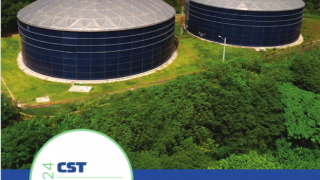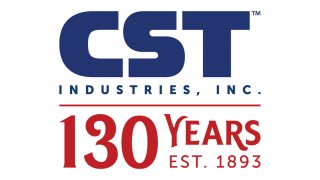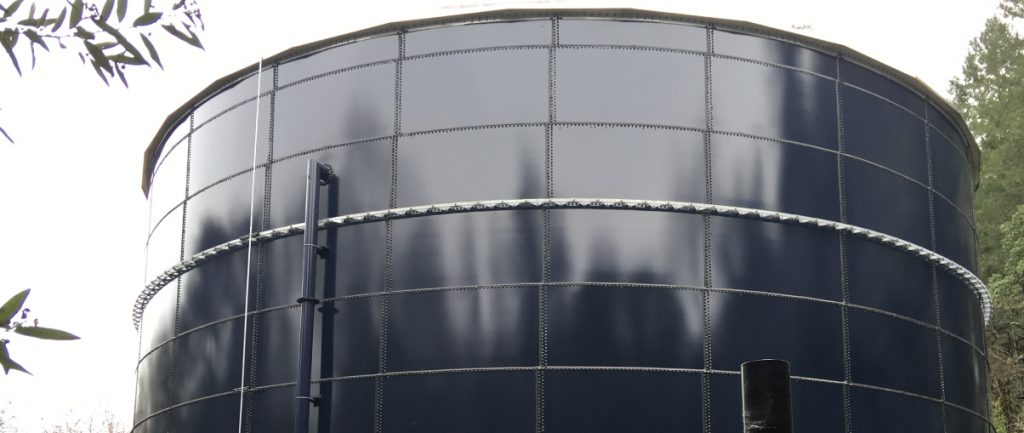
Published in the June 2019 issue of Water Efficiency Magazine
On a “degree of difficulty” scale that’s a 10, the City of Calistoga services over 5,000 residents and shuffling three liquid tanks in a seismic zone without interrupting the water supply of an entire town, is one daunting task.
Derek Rayner has overcome plenty of challenges as deputy public works director for the City of Calistoga, CA, but nothing like the one presented by a 53-year-old seismically deficient steel welded tank that had clearly seen better days. For nearly 50 years, the aging tank serviced the city’s water supply by itself with little fanfare and even less maintenance.
“It was past due for maintenance but we really couldn’t drain it and take it completely offline to sandblast and recoat until another tank was built,” says Rayner. “Besides the expense and the need to take the tank offline, it would still need significant seismic retrofitting, which would be extremely expensive and difficult to do.”
In 2013, a new concrete tank was put in service, giving the city the flexibility to consider the fate of the 53-year-old tank.
The City had previously commissioned Kennedy Jenks to conduct a feasibility study to determine the best course of action: to retrofit or to replace the old tank. The study determined the existing tank was seismically deficient and included an analysis of maintenance and lifecycle costs of various tank types. When comparing those numbers to the cost of rehabbing the 53-year-old tank, the data was convincing. A new tank would cost slightly more than rehabbing the existing one, but when based on lifecycle costs it would cost less for the city to build a new tank, which would require significantly less maintenance over the long term.
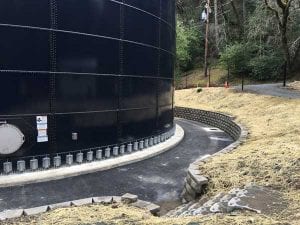
The juggling act began after the Napa earthquake in August 2014, when Rayner started pursuing grant money to fund design and construction of a tank that would meet seismic requirements. The grant application was approved and the search was on for the right tank design.
Prior to his time in Calistoga, Rayner had worked for an engineering consulting firm and remembered conversations with a fellow engineer who’d built a glass-fused bolted tank in nearby Calaveras County. He revisited the idea and consulted California Aquastore, the exclusive provider of CST tanks in the region.
“We were impressed by the promise of minimal maintenance and low lifecycle costs of the Aquastore tank,” says Rayner. “Obviously there’s a large capital cost to install any new tank and in a perfect world you don’t want to have to budget to re-line and re-coat it in 10 or 15 years.”
In the end, the City of Calistoga chose an Aquastore® tank because its glass-fused-to-steel system is developed to meet the demands of liquid storage for the long term. It’s resilient, requires minimal maintenance, has superior fire and seismic resistance and carries the lowest lifecycle costs. Unlike other bolted steel tanks, the Aquastore is virtually seamless, which reduces the likelihood of leaking from within or contamination from the outside.
Fabrication is a multi-step process:
- A panel
of high strength low carbon steel is blasted and alkaline cleaned. - The
panel’s edges are beveled, and its surface sprayed with a steel alloy. - Next, the
panel is sprayed with a specially formulated slurry that gives it durability,
consistency and impermeability. Unlike powder coatings or paint, the slurry is
inorganic so it blocks corrosion. - The
panel is then fired at temperatures above 1,500° F to fuse the porcelain
coating and the steel. - Tests
are conducted to verify integrity and durability, including high voltage
testing to detect discontinuities.
If the decision were this simple, Rayner could leave work on time every day. But living in an active seismic and fire hazard zone, he knows the ground could shake at any time and a tank that isn’t secure could crack, split or topple, leaving the city’s 5,273 residents with a compromised water supply.
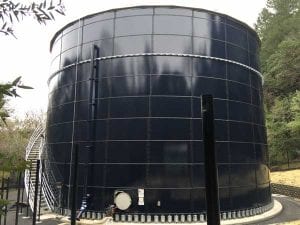
The Napa earthquake of 2014 shook a large portion of northern California, and while Calistoga was 40 miles away from the epicenter and was spared the worst of it, Rayner had always believed that the integrity of the district’s infrastructure would one day be tested. That hunch was reinforced when the Tubbs wildfire burned in October 2017 and forced the evacuation of the entire town.
“We’ve been fortunate because the old tank had no foundation,” says Rayner. “It was just sitting on the ground, held in place by its own weight and the weight of the water inside, and highly susceptible to seismic failure.”
Fortunately, the city had authored a report on the substandard condition of the old tank, which it pulled off the shelf and submitted as evidence to win funding through a FEMA hazard mitigation program. The FEMA money was enough to pay 75% of the cost of the new tank, leaving only 25% of the cost to be picked up by the city.
With the funds allocated, the heavy lifting began. Knowing that the risk of earthquake called for an extraordinary solution, CST engineers set to work designing a tank to meet all applicable seismic codes. First, a large amount of data was imported into the company’s AQUA2 design software, including:
- Seismic site
class - Seismic accelerations
at 1s and 0.2s - Seismic importance
factor - Soil report
Multiple factors were considered, including hoop stress, axial stress, wind stress, seismic stress, hydro dynamic and bolt stress, which were compared against levels allowed by code.
Results from the analysis – including wind shear, wind movement, seismic shear, seismic movement, tank weight and height of the contents – were loaded into the model for the design of the tank’s foundation. Stresses underneath the foundation due to the load combination and overturning were compared with related safety factors, which helped determine the size, number and spacing of the rebar.
Despite the tank’s location in an active seismic zone, the greatest risk to its bolted all-aluminum geodesic dome is wind shear. The dome was designed to meet maximum required wind loads, which surprisingly exceeded seismic loads. CST’s flush batten OptiDome® delivers superior stability, functionality and is aesthetically pleasing.
“Analysis revealed maximum wind reaction drag at a single dome support of 600 pounds and maximum seismic drag of 460 pounds,” says Eduardo Alonso, project engineer at CST. “Due to the low mass to volume ratio of the aluminum dome, seismic effects did not influence the dome design. Instead, applied wind loading on the large surface area on the dome results in the largest horizontal shear reactions.”
With so many variables, collaboration was key to a successful installation.
Says Rayner: “When you’re already working with a consulting engineer to prepare the preliminary designs, it’s important that the tank manufacturer can come in mid-process and you don’t feel any disruption. The entire process was seamless because of the working relationship between Kennedy/Jenks, CST and California Aquastore.”
The tank was shipped in sections from CST’s factory in DeKalb, IL to the site in Calistoga, where assembly was performed using a system of jacks. Porcelain enameled tanks are easier and less costly to assemble than welded or concrete tanks. Using a sidewall erection process, the glass-fused steel panels were bolted together, forming a ring. When completed, the ring was lifted with jacks and the next ring was assembled directly underneath. No crane was needed, therefore allowing erection crews to stay safely on the ground and the whole process took as little as four feet of space beyond the tank foundation.
Calistoga’s new tank sits on a concrete base and is fitted with seismic anchors which will keep it from overturning in case of tremors. All pipes connected to the tank are fitted with special joints that allow the pipe to move in any direction without breaking. A computer monitors the water level, chlorination levels and trihalomethane removal system.
“A tank purchase is a big line item and we like to see customers thoroughly vet their options because it means their ultimate decision is sound and data-based,” says Eric Harper, president and CEO of California Aquastore. “Derek had many options to choose from and he asked a lot of great questions, which I believe we answered to his satisfaction.”
